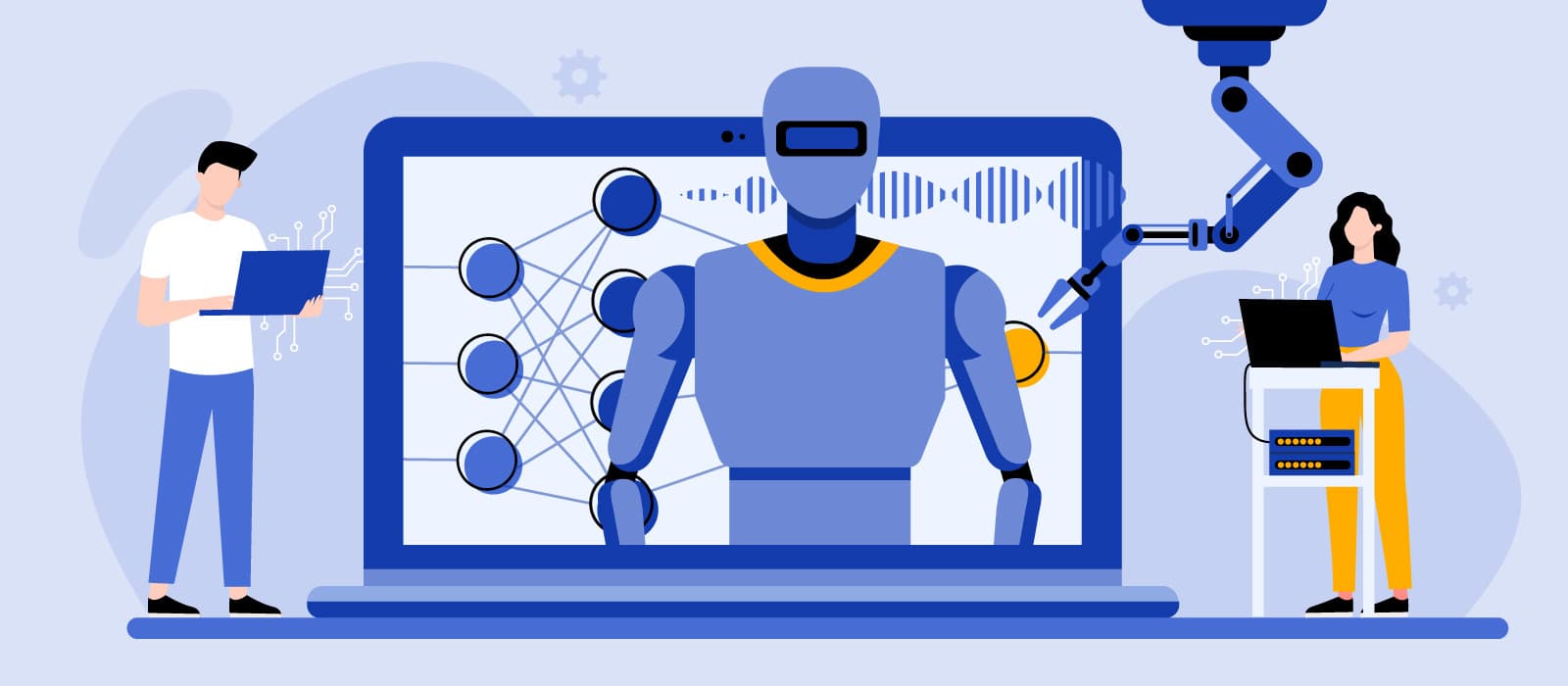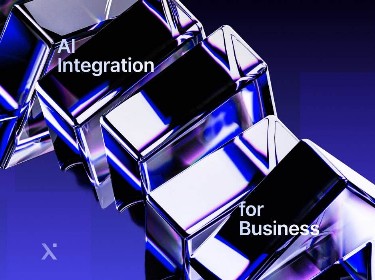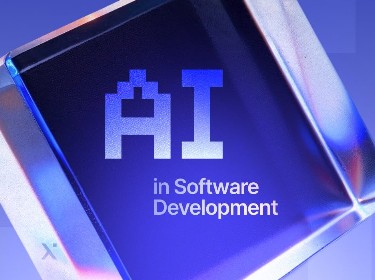From tuning our recommendations on streaming platforms to collecting advanced analytics for businesses – artificial intelligence is now revolutionizing many fields. With new AI solutions being constantly developed, its full potential is yet to be discovered.
These days there is no shortage of information on artificial intelligence (AI). It is perhaps simplest to define AI as training machines to think in a human-like way. The technology is responsible for many commercial products and aspects of our everyday lives that we enjoy today.
On a more technical note, the field of AI can be roughly split into two main branches, “Applied” and “Generalised”. The former focuses on developing software to carry out specific tasks that would otherwise take up considerable time for a person to perform. The latter is aimed at creating intelligent systems having intellectual and emotional capabilities that would allow them to perform numerous tasks with the discretion of a human being.
At the moment, AI is a part of everything, from online shopping to the functionality in our cars, to health and fitness apps we use, and more. With every new turn in its development, it is being described as the “biggest innovation the world has ever seen”. So let’s dive deeper into our outlook on the technology, go under the hood and find out how AI works.
The origins of AI
Artificial intelligence was a term coined by John McCarthy back in 1955. As a subset of computer science, most of its early researchers had qualified in computing, engineering, physics, or maths. Since then AI has slowly been becoming a part of everyday life in some form or another, particularly thanks to the work of pioneers such as Marvin Minsky and Alan Turing.
Following his work in designing the enigma computer, which played a pivotal role in the Second World War, Turing went on to have an academic career in computer science. He wondered how to teach machines “think” in a way similar to that of humans.
Research in the technology was kickstarted by a seminal paper from McCulloch and Pitts which set out the first ideas about using mathematical models to build neural networks. It was the starting point for the development of the field as we know it today. Key milestones in the progress of AI include the first self-learning game of Checkers developed in 1952 by Arthur Samuel, the opening of the first AI Lab by McCarthy at Stanford in 1963, and perhaps the first use of AI in a real-life setting in 1991 for logistics planning during the Gulf War.
Early AI research was centered around basic problem solving and went on to form the foundation for the computer systems and technologies we use today. The idea that computers could be trained to perform reasoning and decision-making in a similar way to the human brain expanded the field and fueled technological advances we see today.
How does AI work?
The basic concept behind modern AI systems is the process of analyzing vast amounts of data, recognizing patterns within that data, and essentially training the software to point out similar patterns in other data sets. This process is generally known as “machine learning”.
Machine learning relies on creating models using mathematics, statistics, and classification methods. One of the most successful at performing tasks is the artificial neural network model crafted based on how our brain operates. The neural network has Information passed between nodes called artificial neurons that are grouped into multiple layers each responsible for their own transformations of the initial data. These transformations help find connections and identify patterns that allow the software to perform various types of tasks.
![]()
Deep learning takes this to the next level, creating more complex networks and making use of the large amounts of data now publicly available. Using these models allows artificial intelligence systems to tackle more serious applications such as computer vision and natural language processing (NLP). These subfields apply deep learning to perform the more challenging tasks such as analyzing video, spotting objects in images, speech recognition, and answering questions provided the information in context and data stored in a knowledge base.
Want to know more about machine learning? Don’t miss this article exploring the technology in detail
Crypto Wallets Get Brain: How AI Crypto Wallet Development is Creating a Smarter and Safer Financial Future
Levels of artificial intelligence
There are generally three stages involved in AI, from the widely used and accepted version of artificial intelligence today to those concepts that are for now considered science fiction.
First here is artificial narrow intelligence (ANI) which is focused on performing a single or specific task. We can see this type of AI system implemented in commercial products we use every day. It includes Google’s keyword tagging and online search engine. It is widely applied in image recognition from Facebook’s face recognition on photos to spotting disease symptoms on medical snapshots. It powers our recommendations on Netflix and Spotify.
However, Narrow AI can never switch between these diverse tasks. It can’t be put in charge to perform all of them. It is well trained at serving its main purpose and would need to integrate with other systems to acquire new features.
Second, there is the more advanced (though still only theoretical) artificial general intelligence (AGI) capable of gathering experience from performing various tasks and applying it to solve any type of challenge. This requires the machine to combine its knowledge, experience, and general reasoning capabilities and make informed decisions.
Since biologists have not yet fully figured out how the brain operates and manages to process multiple sources for information, making General AI a reality still seems a long shot. At the moment, the closest the world has come to implementing AGI is the introduction of supercomputers able to mimic human brain functioning for a very short period of time.
The next level, artificial super intelligence (ASI), is also still yet to be achieved. This level is also referred to as “machine consciousness” and is meant to surpass the intellectual capabilities of the human brain in terms of both performance and the tasks that could be achieved. ASI is the kind of software that would have superior intelligence in all subjects and fields, in addition to having emotions, needs, and beliefs just as we do. This will allow it to not only make decisions based on reasoning but also take moral issues into account.
It is believed that we still have quite a long way to go from Narrow AI to General AI. Making the leap from AGI to ASI, however, would not necessarily be a big one, given the increasing speed of development and the potential of AI to learn and train itself.
Why AI is so important and beneficial
AI is not only making our everyday lives easier and more convenient, it is now having an impact on almost every aspect of modern business. Its reach extends, from medicine to banking, to the eCommerce apps we use every day. It has made much of 21st-century digital life what it is today, particularly in terms of the convenience of smart technology.
Most benefits of AI for any industry involve speeding up data discovery. The more information you feed a computer, the quicker the technology can acquire new skills and spot patterns. The deeper the learning – that is, the deeper the neural networks, combined with the immense computing power and the collection of data sets – the better the accuracy and sophistication of AI. Although human intervention may still be needed, once set up and trained, these AI systems can process high volumes of data, extract insights from it, and use that data to solve critical business problems.
“In our business, we talk about emerging technologies and how they impact society. We’ve never seen a technology move as fast as AI has to impact society and technology. This is by far the fastest moving technology that we’ve ever tracked in terms of its impact and we’re just getting started.” ― Richard Socher, Salesforce
Modern applications of AI solutions
![]()
AI is having a significant impact across a number of industries. It is forecasted that the global AI market will reach $500 billion by 2024. AI is behind voice recognition technologies, the apps that can control lights and appliances, and complex security systems that protect our properties. Alongside these are technologies that we now take for granted, such as Apple’s Siri and Google’s virtual assistant. Streaming services such as Netflix use it to come up with our recommendations. AI plays an even greater role in online shopping platforms, helping brands create new marketing moves to sell their products.
The application of artificial intelligence is only going to become more widespread, specifically thanks to the rise of chatbot development services. Having to spend so much time on hold is no longer an issue when contacting customer service. With the wide adoption of self-driving cars on the horizon, we are likely to see the proliferation of Uber-style services, and the potential to enable disabled people to drive freely to their location without any restrictions.
In medicine, for instance, playing a deciding role in diagnostics, drug development, and the emergence of personalized medicine, AI creates more space for doctors to focus on providing better treatment. Artificial intelligence can more easily and effectively identify tumors and lesions in medical images. It shows much better results in recognizing target proteins, the specific biomarkers, and the structural fingerprints of potential drug molecules during clinical trials.
In an academic setting, the technology is being applied to make progress in complex theoretical scientific research such as quantum physics. It is widely being used for modeling and predicting the behavior of systems consisting of billions of subatomic particles. In the world of finance, AI is helping to identify and prevent fraud, analyze financial status to calculate credit scores, and boost the decision-making process by providing accurate predictions.
It is also streamlining manufacturing processes, from ordering materials and organizing a workforce to identifying potential mishaps or errors before they escalate. Tailoring customer service and pre-empting customer needs in order to provide an all-round better and friendlier service are also the things artificial intelligence systems are highly capable of.
Find out how AI benefits oil, gas and mining industries in this article
Are there any risks or downsides to incorporating AI?
![]()
One big issue with AI is that it is only as smart as the data it is fed. At the moment, AI systems rely on specific methods to perform a specific task. So a system that has learned to recognize speech cannot then also be used for facial recognition, as this would require new data sets and the model would need to be trained on them.
As a result, there is often a divide between expectation and reality when it comes to implementing an AI system. If the correct model or data set is not used as the foundation of an AI solution, it may fall short. Ultimately, you will not gain the advantages you wanted as compared to the expenses of training the AI. Even training a single model can give you a bundle in computational overheads.
Questions continue to surface with regard to manual labor being replaced by machines. Many people are also hesitant to become fully reliant on machines controlling their daily lives and their safety. Although research has proven that autonomous vehicles cause much fewer accidents than human drivers, many people still stray away from the idea of smart cars and would rather rely on a regular driver to take them to work.
Fortunately, questions such as these are being addressed through the establishment of groups such as the Partnership on AI. Global leaders such as Google, IBM, Microsoft, Facebook, and Amazon have all opened up projects and initiatives supporting AI development. These parties sometimes work in collaboration to formulate best practices on AI, advocate for ethical implementation, and create guidelines for development and research.
From a practical point of view, the risk associated with the widespread implementation of AI solutions is minimal in comparison to the benefits it can provide.
The challenges of working with AI
Sometimes the AI system’s design may require a high level of expertise and experience from regular users or even experienced personnel. At the same time, there can also be a lack of understanding of how AI can really help to transform the business workflow. Consequently, there is a need for efficient research and development services as well as training and educating the entire staff, from operators themselves to those being in charge of maintenance for the supportive infrastructure that hosts the AI system, whether it be on-premise or cloud.
Relying on automated AI systems to run our business is fine – until there is some kind of malfunction and we need to call in the experts to optimize the system. We also need to keep in mind that the software is only as smart as the data we feed it. This means it needs to be designed and set up properly in order to ensure it works without fouls and completes its tasks efficiently.
Conclusion
AI is having a strong impact on our everyday lives and forms the backbone of many innovative platforms used by businesses across industries. Based on the concept of software models able to learn from data and train themselves to improve their results, solutions that incorporate AI technology prove to be much more effective than traditional systems. They are being considered as the driving factor for innovation and progress as many companies already use them to streamline processes, increase efficiency, and provide better services to customers.
If you are looking to include AI features in your next project or planning on creating a smart solution from scratch, a trusted AI development partner is the best place to start. We can help you by analyzing if artificial intelligence is a viable solution for your business, provide artificial intelligence and machine learning consulting services, plan out development and integration processes, and support you all the way through deployment.




